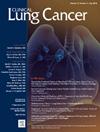Participation in Non-small Cell Lung Cancer Clinical Trials in the United States by Race/Ethnicity
IF 3.3
3区 医学
Q2 ONCOLOGY
引用次数: 0
Abstract
Introduction
Despite efforts by Cancer Centers and community organizations to increase diversity in clinical trials, significant racial/ethnic disparities remain. Given the high mortality rates in non-small cell lung cancer (NSCLC), it is important to increase diversity in NSCLC trials, ensuring all patients benefit from advances in new treatment modalities.
Materials and Methods
We evaluated the distribution of racial/ethnic minority enrollment in NSCLC clinical trials using data from ClinicalTrials.gov. We extracted trial characteristics, including start year, study phase, tumor stage, sample size, sponsor, geographic region, and masking. The number of participants by race/ethnicity was obtained from ClinicalTrials.gov or linked publications. Using annual NSCLC incidence data from SEER*Stat for each racial/ethnic group from 2010 to 2019, we applied a 2-sample test for equality of proportions with continuity correction to assess differences between incidence and trial participation.
Results
A total of 147 unique studies were included in the final analysis. Of the 28,540 participants, 79.6% were White, with 3% Black, 10.4% Asian or Pacific Islander and 3.4% Hispanic/Latino. Most participants were enrolled in phase III trials (63.8%), industry-sponsored (93.9%), and open-label (67.7%). Black patients were more commonly enrolled in academic sponsored trials and less commonly enrolled in masked (i.e., blinded) studies. When comparing trial participation to annual incidence data, we observed underrepresentation among Black participants (Difference: −7.9%) and Hispanic/Latino participants (Difference: −3.2%).
Conclusion
Persistent underrepresentation exists in NSCLC clinical trials among Black and Hispanic/Latino patients. We urge further investigation of these findings through well-designed clinical trials among diverse patient populations.
按种族/族裔分列的美国非小细胞肺癌临床试验参与情况。
导言:尽管癌症中心和社区组织努力提高临床试验的多样性,但种族/民族差异仍然很大。鉴于非小细胞肺癌(NSCLC)的高死亡率,提高NSCLC试验的多样性非常重要,这样才能确保所有患者都能受益于新治疗模式的进步:我们利用ClinicalTrials.gov的数据评估了NSCLC临床试验中少数种族/人种入组的分布情况。我们提取了试验特征,包括开始年份、研究阶段、肿瘤分期、样本大小、赞助商、地理区域和掩蔽。按种族/民族划分的参与者人数来自 ClinicalTrials.gov 或链接的出版物。利用SEER*Stat提供的2010年至2019年各种族/族裔群体的NSCLC年度发病率数据,我们采用了带连续性校正的2样本比例相等检验来评估发病率与试验参与度之间的差异:共有 147 项独特的研究被纳入最终分析。在 28,540 名参与者中,79.6% 为白人,3% 为黑人,10.4% 为亚洲人或太平洋岛民,3.4% 为西班牙裔/拉丁美洲人。大多数参与者参加了 III 期试验(63.8%)、行业资助试验(93.9%)和开放标签试验(67.7%)。黑人患者更常参加学术赞助的试验,而较少参加蒙面(即盲法)研究。在将试验参与情况与年度发病率数据进行比较时,我们观察到黑人参与者(差异:-7.9%)和西班牙裔/拉丁裔参与者(差异:-3.2%)的代表性不足:结论:黑人和西班牙裔/拉丁美洲裔患者在 NSCLC 临床试验中的代表性持续不足。我们敦促通过在不同患者群体中进行精心设计的临床试验来进一步研究这些发现。
本文章由计算机程序翻译,如有差异,请以英文原文为准。
求助全文
约1分钟内获得全文
求助全文
来源期刊

Clinical lung cancer
医学-肿瘤学
CiteScore
7.00
自引率
2.80%
发文量
159
审稿时长
24 days
期刊介绍:
Clinical Lung Cancer is a peer-reviewed bimonthly journal that publishes original articles describing various aspects of clinical and translational research of lung cancer. Clinical Lung Cancer is devoted to articles on detection, diagnosis, prevention, and treatment of lung cancer. The main emphasis is on recent scientific developments in all areas related to lung cancer. Specific areas of interest include clinical research and mechanistic approaches; drug sensitivity and resistance; gene and antisense therapy; pathology, markers, and prognostic indicators; chemoprevention strategies; multimodality therapy; and integration of various approaches.
 求助内容:
求助内容: 应助结果提醒方式:
应助结果提醒方式:


